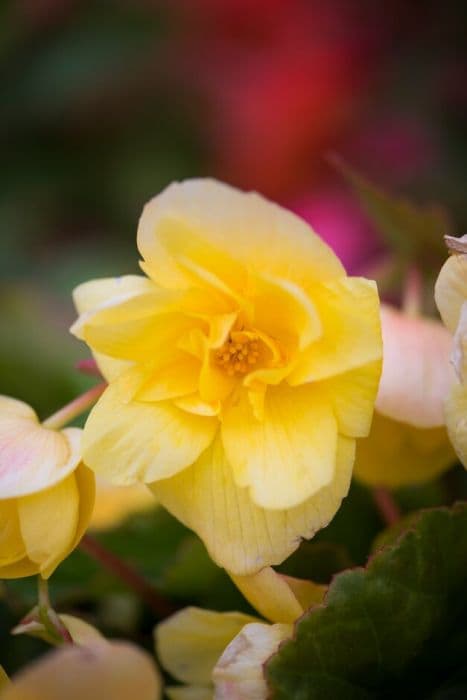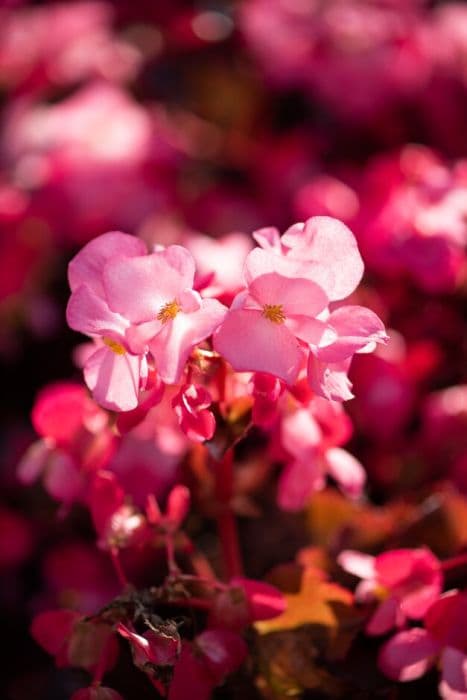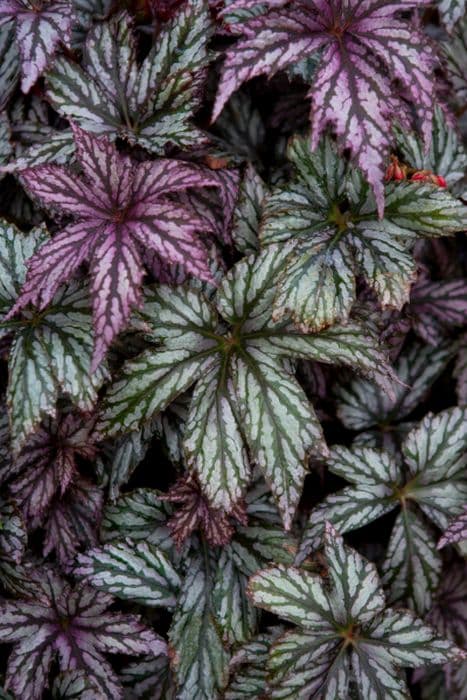Polka dot begonia Begonia maculata 'Wightii' (C)

ABOUT
Begonia maculata 'Wightii', commonly known as Polka Dot Begonia, is a striking houseplant that is admired for its distinctive foliage. Each leaf on this plant is a showcase of nature's artistry, being a lush green color and adorned with bright, silvery-white spots that give it the appearance of having been sprinkled with polka dots. The leaves themselves have an elongated, oval shape with pointed tips, and their edges are intricately serrated, creating a wave-like pattern along their margins. The underside of the leaves tells a different color story, with a dramatic reddish-purple hue that adds a bold contrast to the cool tones of the leaf tops. As sunlight filters through the leaves, their translucency is made apparent, adding a luminous quality to the leaf's textured surface. Polka Dot Begonia is not only loved for its leaves; it also blooms with delicate flowers when given the right conditions. The flowers are typically small and clustered, often in shades of white or a light pink, which dangle elegantly like dainty chandeliers from the plant's stems. Although the flowers are less showy than the foliage, they contribute an extra dash of charm to the plant's overall appearance. Structurally, Polka Dot Begonia has a semi-upright habit, with stems that can arch gracefully under the weight of the large leaves. Its stems are also noteworthy, bearing a resemblance to bamboo with their jointed appearance, and have a succulent quality. This beguiling combination of patterned leaves, contrasting colors, and structural elegance makes Polka Dot Begonia a beloved ornamental plant among enthusiasts.
About this plant
 Names
NamesSynonyms
Polka Dot Begonia, Spotted Begonia, Trout Begonia, Polka Dot Plant.
Common names
Begonia maculata 'Wightii'
 Toxicity
ToxicityTo humans
The common name of Begonia maculata 'Wightii' is Polka Dot Begonia. Polka Dot Begonia is considered non-toxic to humans. However, it's always wise to keep houseplants out of the reach of small children who might ingest plant parts out of curiosity. Although not toxic, if ingested, it might cause mild discomfort in the stomach.
To pets
The common name of Begonia maculata 'Wightii' is Polka Dot Begonia. Polka Dot Begonia is considered toxic to pets. If a pet ingests any part of the plant, they may experience symptoms such as irritation of the mouth, salivation, vomiting, and difficulty swallowing. It is important to keep this plant away from pets to avoid these potential consequences. If you suspect your pet has ingested part of a Polka Dot Begonia, it is best to consult with a veterinarian promptly.
 Characteristics
CharacteristicsLife cycle
Perennials
Foliage type
Evergreen
Color of leaves
Variegated
Flower color
White
Height
1-2 feet (30-60 cm)
Spread
1-2 feet (30-60 cm)
Plant type
Herb
Hardiness zones
10
Native area
Brazil
Benefits
 General Benefits
General Benefits- Aesthetic Appeal: The Begonia maculata 'Wightii', commonly known as the Polka Dot Begonia, features unique silver-polka-dotted leaves and a vivid red underside, making it a visually striking addition to any indoor space.
- Easy Propagation: This plant can be easily propagated from stem cuttings, allowing plant enthusiasts to create new plants and share with friends and family.
- Humidity Lover: Polka Dot Begonia thrives in humid environments, making it suitable for bathrooms or kitchens where humidity levels are naturally higher.
- Mental Wellbeing: Like many houseplants, caring for Polka Dot Begonia can provide a sense of accomplishment and relaxation, contributing to overall mental wellbeing and stress reduction.
- Adaptable to Indoor Environments: It grows well in a variety of indoor conditions, making it a versatile choice for many home and office environments.
- Non-Toxicity: Although some begonias can be toxic if ingested, the Polka Dot Begonia is generally considered non-toxic, making it a safer choice for homes with pets and children.
 Medical Properties
Medical PropertiesThis plant is not used for medical purposes.
 Air-purifying Qualities
Air-purifying QualitiesThis plant is not specifically known for air purifying qualities.
 Other Uses
Other Uses- Begonia maculata 'Wightii', commonly known as Polka Dot Begonia, can be used as an educational tool in botany classes to demonstrate plant propagation techniques such as stem cuttings or leaf cuttings.
- In arts and crafts, the striking leaves with polka dots can be used as natural stencils for painting or imprinting patterns on fabrics and paper.
- The patterned leaves of the Polka Dot Begonia add aesthetic appeal to terrariums, creating a visually interesting environment when combined with other plants and decorative elements.
- During festive seasons, the Polka Dot Begonia can be given as a living gift that is both unique and sustainable compared to cut flowers.
- The plant can be used in photography projects or social media content for those who blog or post about interior design and houseplant collections.
- Polka Dot Begonia can inspire fashion designs and textile patterns with its distinctive foliage, influencing industries outside of horticulture.
- The plant's ability to thrive under fluorescent lighting makes it suitable for office spaces, adding a touch of nature to the work environment.
- With its unique appearance, the Polka Dot Begonia can be used as a conversation starter in social settings, sparking discussions about horticulture and plant care.
- Begonia enthusiasts may use the plant in horticultural shows and competitions, where its distinctive features can be judged against other ornamentals.
- In a classroom setup, the Polka Dot Begonia can be a living subject for art classes, where students can draw or paint its interesting patterns and shapes.
Interesting Facts
 Feng Shui
Feng ShuiThe Polka Dot Plant is not used in Feng Shui practice.
 Zodiac Sign Compitability
Zodiac Sign CompitabilityThe Polka Dot Plant is not used in astrology practice.
 Plant Symbolism
Plant Symbolism- Caution: Begonia maculata, commonly known as Polka Dot Begonia, often serves as a reminder to be cautious or to tread carefully in new situations, as begonias have historically been associated with warnings or misgivings.
- Unique Beauty: With its distinct spotted leaves, the Polka Dot Begonia symbolizes uniqueness and stands as a representation of individual beauty that stands out in a crowd.
- Harmony: The Polka Dot Begonia promotes a sense of balance and harmony, reflecting its even patterns and symmetry which indicate the equilibrium in life.
- Gratitude: Giving a Polka Dot Begonia can express gratitude or thankfulness, as begonias have been linked to feelings of appreciation and sincere acknowledgement.
 Water
WaterThe Polka Dot Begonia should be watered thoroughly once the top inch of soil feels dry to the touch, typically every 1-2 weeks, depending on environmental conditions. Water the plant with room temperature water until it begins to drain from the bottom of the pot, then allow it to fully drain before placing it back on its saucer. This plant is sensitive to overwatering, so it's crucial to ensure the pot has adequate drainage. Generally, you may need approximately 16-24 ounces of water for an average-sized pot, at each watering interval.
 Light
LightPolka Dot Begonia thrives in bright, indirect sunlight. The best spot for it is near an east or west-facing window where it can receive plenty of light without being exposed to the harsh midday sun. Avoid direct sunlight as it can scorch the delicate leaves of the plant.
 Temperature
TemperaturePolka Dot Begonia prefers temperatures between 65-75°F and should be protected from temperatures below 60°F and above 85°F. They like a relatively warm and stable environment without drafts or sudden temperature changes.
 Pruning
PruningPruning Polka Dot Begonia encourages bushier growth and should be done as needed to remove any dead or yellowing leaves. The best time for pruning is in the spring as the plant resumes active growth. Trimming can be done every few months to maintain the desired shape and size.
 Cleaning
CleaningAs needed
 Soil
SoilPolka dot begonia thrives in well-draining potting mix with a pH of 6.0 to 7.0. A mix of one part peat, one part pine bark, and one part coarse sand or perlite works best for proper drainage and aeration.
 Repotting
RepottingPolka dot begonia should be repotted every 1-2 years in spring or when it outgrows its pot, being careful not to damage the delicate roots.
 Humidity & Misting
Humidity & MistingPolka dot begonia prefers high humidity levels, ideally between 50-60%. Less humidity can lead to leaf crisping and brown edges.
 Suitable locations
Suitable locationsIndoor
Provide bright, indirect light and high humidity.
Outdoor
Keep in filtered light, protected from harsh sun.
Hardiness zone
10-11 USDA
 Life cycle
Life cycleThe Polka Dot Begonia (Begonia maculata 'Wightii') begins its life as a seed, sprouting into a seedling when environmental conditions such as light, temperature, and moisture are favorable. As the seedling establishes its roots and grows, it develops into a vegetative state, putting out characteristic broad leaves with silver polka dots and a red underside. The mature plant will produce clusters of white flowers, usually in the warmer months of spring or summer, depending on the climate. After flowering, fertilized flowers may set seed, completing the reproductive cycle. Throughout its life, the plant will continue to produce new leaves and may require occasional pruning to maintain its shape and encourage bushier growth. The Polka Dot Begonia can be propagated through leaf cuttings or division, where parts of the plants are separated and potted as new plants, thus continuing its life cycle.
 Propogation
PropogationPropogation time
Spring-Early Summer
The Polka Dot Begonia, commonly referred to as Begonia maculata 'Wightii', can be propagated effectively through stem cuttings. The ideal time to propagate is during the spring or early summer when the plant is actively growing. The process begins with taking a healthy stem cutting, preferably with several leaves and at least one node, as this is where new roots will emerge from. The cutting should be about 4 inches (approximately 10 centimeters) long. The stem cutting is then placed either directly in soil or in a glass of water. If using water, once roots have developed to a length of about 1 inch (about 2.5 centimeters), it can be transplanted to a pot with suitable potting mix. For those opting for soil propagation, the cutting should be planted in moist soil and kept in a warm place with bright, indirect light until roots have established.





![Begonia [Devotion]](/_next/image?url=https%3A%2F%2Fplants-admin.emdemapps.com%2Fimages%2Fplants%2F%2Fimages%2F604b58183573b.png&w=640&q=75)



